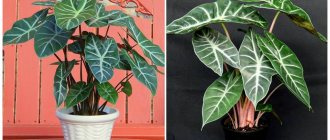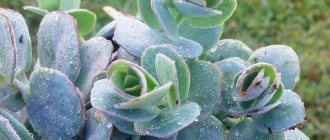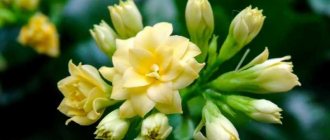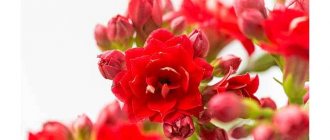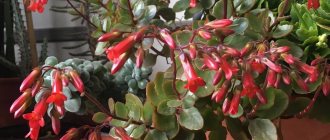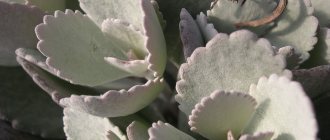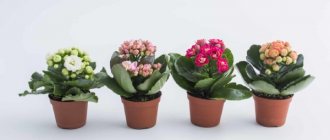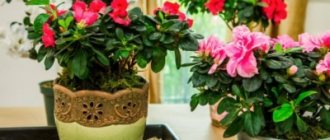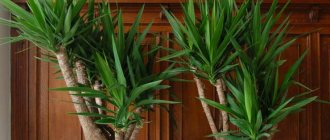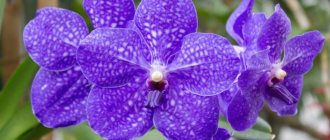Author: Elena N. https://floristics.info/ru/index.php?option=com_contact&view=contact&id=19 Category: Houseplants Published: July 30, 2013Last edits: November 30, 2020
- Kalanchoe bentii / Kalanchoe bentii
Botanical description
Kalanchoe (lat. Kalanchoe) - depending on the species, they can be herbaceous perennials, subshrubs or succulent plants. In total, more than 200 species of Kalanchoe are known, and the genus itself is part of the Tolstyankov family. Natural habitat - tropical zones of Australia, Asia and America. The leaves of different species differ from each other. Usually thick, may be strongly or weakly dissected, may be sessile, or may have a petiole. Red, white, yellow or purple flowers are collected in umbrella-shaped inflorescences. Almost all types of Kalanchoe tolerate growing indoors well. The main thing is to follow the recommendations for caring for Kalanchoe at home.
Varieties of plants with bright yellow and orange inflorescences and their photos
Next, you can learn about the most common types of plants that have yellow and orange flowers, read their descriptions and look at the photo.
Popular plant types:
- "Blossfeld" is a popular decorative species. The leaves are smooth, dark green. The plant comes in white, pink, red and yellow colors.
- "Alexandra" is a popular variety of yellow Kalanchoe, which is characterized by single, yellow, tubular-shaped flowers.
- “Bardot” is a variety with double inflorescences of bright orange color. It has long flowering.
Common varieties of yellow Kalanchoe include:
- "Naomi."
- "Arina".
- "Karen."
- "Ingrid."
- "Goldstrike."
- "Fonda".
- "Nadya-2000".
- "Carmen"
"Naomi":
"Blossfeld":
"Alexandra":
"Ingrid":
"Fonda":
Briefly about cultivation
- Flowering: within a month from the end of winter.
- Lighting: daylight under bright diffused light should last 12 hours.
- Temperature: in summer – from 18 to 28 ºC, in winter – from 14 to 18 ºC. Lowering the temperature to 10 ºC or lower is unacceptable.
- Watering: through a tray: during the growing season - moderate, as soon as the top layer of the substrate dries, in winter the substrate should dry by a third between waterings.
- Air humidity: normal for residential premises, but in hot weather spraying with warm water is recommended.
- Feeding: in summer and autumn (during budding) - weekly fertilizer for cacti and succulents. Organic fertilizers can be applied no more than twice a month.
- Pruning: After flowering, you need to trim off all flower stalks.
- Dormant period: within 1-1.5 months after flowering.
- Transplantation: at the beginning of active growth, after the roots of the plant fill the pot.
- Substrate: four parts turf soil, two parts leaf and one part each peat and sand. A ready-made substrate for succulents and cacti is also suitable.
- Reproduction: seeds and cuttings.
- Pests: mealybugs, scale insects, spider mites, aphids.
- Diseases: powdery mildew, late blight, gray rot, stem rot, leaf ring spot.
- Properties: Kalanchoe is a medicinal plant with anti-inflammatory, antibacterial, wound-healing, hemostatic and bactericidal effects.
Read more about growing Kalanchoe below.
Protection from pests and diseases
The most harmful insects and diseases for Kalanchoe Yellow are:
Aphids are capable of sharply inhibiting the growth and flowering of a bush and multiply quickly, so measures to destroy them must be urgent. First, we wash the plant under a warm shower, wipe the leaves, and then treat it with any insecticide. After these procedures, you need to quarantine the plant in a place separate from other flowers (for a week).- Scale insects - if detected, you must immediately cut off all the affected parts and treat the sections with charcoal, then wipe all remaining leaves with an alcohol solution or treat them with potassium laundry soap (special for pest control), and then pour in a fungicide.
- Powdery mildew - at low temperatures but excessive humidity - you urgently need to change the regime of keeping Kalanchoe.
- Late blight - can appear with excess fertilizer, extreme heat and overwatering - you need to remove the affected leaves, treat with charcoal and urgently establish the correct regime for the flower.
Caring for Kalanchoe at home
Lighting
For Kalanchoe at home, the optimal daylight hours are 12 hours. Therefore, the best place for a pot of Kalanchoe from spring to autumn is windows on the east or west side. In winter, it is better to place the flower on a southern windowsill. If daylight hours in winter are very short, then it should be brought to the required level with the help of additional artificial lighting.
Temperature
The Kalanchoe flower feels good indoors at almost any temperature. Within reasonable limits, of course. These limits range from 18 to 28 °C in summer, and from 14 to 18 °C in winter. A decrease in temperature below 10 °C threatens disease and death of Kalanchoe. Low temperature (14-18 °C) promotes bud formation.
Watering Kalanchoe
Homemade Kalanchoe is watered with soft, warm, settled water. Water as the top layer of soil dries, under no circumstances allowing the earthen clod to dry out completely - this leads to a massive fall of Kalanchoe leaves. In winter, water 3-4 days after the substrate dries. Watering can be done through the tray.
- Hydrangea at home: care and propagation
Spraying
The indoor Kalanchoe plant does not need spraying, but in hot weather this will only have a positive effect on the development of the plant. If the plant is not sprayed, nothing bad will happen. The leaves of the indoor Kalanchoe flower are fleshy, sometimes pubescent, and moisture evaporates weakly.
Top dressing
Kalanchoe needs fertilizer only in the summer, as well as during the budding period in the fall. You can use the same fertilizers that are intended for feeding cacti. In summer, mineral fertilizers are used 4 times a month, and organic fertilizers – 2 times.
Trimming
Since many types of Kalanchoe shed old leaves, these shoots can be trimmed and planted separately or in the same pot. In other species, the shoots overflow the edge of the pot - they can also be trimmed and planted nearby, or they can be left hanging.
Bloom
For good flowering, daylight hours in the spring-autumn period should be no more than 10-12 hours, but the lighting at this time should be very bright. Flowers of some varieties can be cut and placed in a vase, where they can last for several weeks. When indoor Kalanchoe has faded, some of the stems are cut off, giving the plant a beautiful appearance. Do not throw away the cut shoots, but use them for cuttings.
Replanting Kalanchoe
Kalanchoe is replanted only if the plant has grown greatly. Expanded clay or small bricks are poured into the bottom of the pot, which will allow excess water to drain away. Young specimens are planted in a substrate consisting of turf soil, deciduous soil, sand and peat (4: 2: 1: 1). You can use store-bought substrate for succulent plants. For epiphytic Kalanchoe, it would be a good idea to add a little humus to the soil mixture.
Propagation by cuttings
You can root either a piece of the stem or a leaf. All you need to do is separate the leaf from the mother plant in early summer and plant it in nutritious soil. The leaf should be covered with a jar and sprayed from time to time. Soon the leaf will sprout roots.
- Kerria: growing in the garden, types and varieties
Growing from seeds
Kalanchoe reproduces well by seeds. Sowing of seeds is carried out at the end of winter - beginning of spring in deciduous soil. Sow on the surface, then press down with your finger, without sprinkling soil on top. The container with seeds is covered with glass and paper, ventilated in the morning and evening, and the temperature is not allowed to drop below 16 °C or rise above 20 °C. The earth is regularly watered with warm water, not allowing it to dry out completely. When the first shoots appear, the glass and paper are removed. After 3-4 weeks, the sprouts dive into a larger container. The next transplant is done when the Kalanchoe has 3-4 leaves. Drainage is poured onto the bottom of the pot, and a mixture of peat, turf soil and sand (4:2:1) is placed on top. When the indoor Kalanchoe flower takes root, the top needs to be pinched for better branching. The Kalanchoe is replanted the next time the roots fill the pot. The soil is made up of compost, humus, leafy soil and sand (4:2:1:1). The first flowering can be observed next year.
How to care for a flowering plant?
Kalanchoe is not a very demanding plant to care for, so it is recommended for cultivation even by novice gardeners. Proper care of it must be carried out according to the following algorithm:
- provide moderate watering and appropriate lighting;
- lift the leaves during irrigation so that droplets of water do not fall on them;
- protect the bush from cold and drafts;
- apply fertilizers to the soil from June to November (before flowering);
- trim wilted leaves and flower stalks.
What happens to the plant during this period?
Kalanchoe blooms only once a year . Since the birthplace of the flower is Africa, Southeast Asia, and South America, budding in our latitudes lasts from mid-winter to March.
During flowering, the bush is decorated with a scattering of bright inflorescences.
This period can last until summer, it depends on the variety. It is also possible to artificially prolong flowering by removing dried inflorescences after the end of the first wave of budding and providing the bush with additional nutrition for the formation of new buds.
Reference . It is not always possible to cause Kalanchoe to bloom again. This is especially true for unkempt and sick specimens. During such stagnation, the stems stretch out, the bush grows and takes on an unkempt appearance, so many gardeners rush to get rid of it and start a new one.
Kinds
Kalanchoe bentii / Kalanchoe bentii
This Kalanchoe is native to the Arabian Peninsula. The species is represented by powerful subshrubs that grow up to 1 m in height. The leaves are thick and long - almost up to 0.5 m, round in shape, growing in six pairs. White flowers grow on an umbrella-shaped inflorescence. Flowering period mid to late spring. Feels best in cool rooms.
Kalanchoe beharensis / Kalanchoe beharensis
Lives in the south of Madagascar. The species is represented by shrubs. The shoots of this species become bare from below over time. The leaves are covered with hairs; the edge of the leaf can be solid or slightly jagged. The flowers are less than 1 cm long and also pubescent.
- Smithiantha - care, photos, types
Kalanchoe blossfeldiana
Habitat: Madagascar island. The species is represented by erect, low shrubs - up to 30 cm in height. The leaves are green with red edges, ovoid in shape (length - 7 cm, width - 4 cm), not pubescent. The flowers are red, erect, and collected in umbrella-shaped inflorescences. The usual flowering period is from late winter to early summer. Forms with orange, yellow, white, pink and other flowers have been developed.
Kalanchoe tomentosa
Lives in Madagascar. The species is represented by subshrubs. The shoots are pubescent and erect. The leaves are sessile, elongated-ovate (up to 6 cm long and up to 1.5 cm wide), the edge is smooth. Small flowers grow on an umbrella-shaped inflorescence.
Kalanchoe daigremontiana
Habitat: Madagascar. This species is a herbaceous perennial that grows up to 0.5 m in height. The leaves are variegated from top to bottom. The upper part of the leaf is gray-green, the edges are uneven, not pubescent, elongated-elliptical in shape (up to 10 cm long). The leaves are covered with purple spots. The inflorescence is a panicle. Corolla tube up to 1.5 cm long, petals up to about 5 mm long, pink. Flowering period is winter.
Kalanchoe grandiflora
Also known as Kalanchoe marmorata. This genus is from India, a subshrub slightly more than 0.5 m in height. The leaves are green (may become reddish over time if the flower is in the sun), coarsely toothed. Petioles are short. The flowers are pale yellow, collected in umbrella-shaped inflorescences. The flowering period is May, it smells very nice.
Kalanchoe manginii / Kalanchoe manginii
This is an ampelous species of Kalanchoe that is very similar to Kalanchoe Blossfeld, but differs in having larger flowers that droop rather than being erect. The flowering period usually occurs in spring.
Kalanchoe paniculata / Kalanchoe thyrsiflora
These are tall herbaceous perennials (up to 60 cm tall). The leaves are egg-shaped, tapering towards the base, up to 15 cm long and up to 7 cm wide. The leaves grow densely at the base and the higher they are, the rarer and smaller new silvery-white leaves grow. It blooms at the end of spring with yellow flowers up to 1.5 cm long, petals up to 5 mm in diameter. It reproduces well by children that appear after flowering.
Marbled Kalanchoe / Kalanchoe marmorata
This species has many names and is also known as Kalanchoe grandiflora and Kalanchoe somaliensis. Grows in the mountains of Ethiopia. These are Kalanchoe - half-meter shrubs. The leaves are green (grey over time) covered with lilac or brown spots. The leaf shape is ovoid, but the leaf tapers at the base and has indentations along the edge. White flowers are collected on an umbrella-shaped inflorescence. The corolla tube is up to 8 cm long, the petals have the shape of an elongated egg.
Kalanchoe pinnata / Kalanchoe pinnata
Homeland - Madagascar. Tall herbaceous perennials - reach 1 m in height. The leaves on the same plant are different from each other. The lower leaves are simple, usually ovate with a heart-shaped base, while the lower leaves are pinnate, with three to five leaflets. Leaf color is green. The corolla tube is white-green, and the petals are reddish.
Kalanchoe flammea / Kalanchoe flammea
It can be found under the name Kalanchoe glaucescens. Homeland: Somalia. Low herbaceous perennials that reach a height of 40 cm. The leaves are ovoid, up to 8 cm long and up to 3 cm wide, tapering at the base, widely rounded on the other side, serrated. The flowers are bright red and bright orange, collected in umbrella-shaped inflorescences. The petals are up to 2 cm in diameter, the corolla tube is slightly expanded.
Kalanchoe tubiflora
Originally from Madagascar. This species is a tall subshrub or herbaceous perennial, growing up to 70 cm in height. The leaves are narrow, green with a gray tint and covered with brown spots, reaching up to 12 cm in length. The corolla tube is up to 2.5 cm long, red.
Kalanchoe dissected (lobed) / Kalanchoe laciniata
Herbaceous perennial from Africa. The shoots are fleshy, become bare over time and begin to droop towards the ground. The leaves are serrate, dense and fleshy, strongly dissected, waxy, light green in color. The flowers are yellow-orange, tubular.
Soil requirements
For planting, it is better to use soil with the following composition:
- 1 part compost;
- 1 part sand;
- 2 parts of turf land;
- 4 parts of deciduous soil.
Soil for planting can be made at home or purchased ready-made in a store. If you choose a purchased one, then you should pay attention to special soil for succulents. It does not retain moisture in the soil.
Before planting, the soil is disinfected. This is done using wood ash. This solution will disinfect the soil and saturate it with useful minerals.
Preparation of the solution:
- Mix 1 liter of water and 1 tbsp. ash.
- Boil the mixture.
- Pour into the soil and mix.
- Dry the soil slightly.
Attention! The soil can be treated with a solution of potassium permanganate or calcined in the oven.
Proper pruning
For some plant varieties, pruning is an essential part of care. This is especially true for flowering species. How to prune Kalanchoe? The pruning procedure must be drastic. The flower stalks are cut off completely, leaving no extra parts. Very often, flowering greatly weakens the plant. In this case, you will have to cut off all the bad looking and old parts of the flower. At the same time, young and strong shoots can be cut off and used for propagation of Kalanchoe. In summer, flower growers recommend pinching off the top so that new side shoots appear. If this is not done, the plant will stretch.
How to prune a Kalanchoe that does not bloom? Even non-flowering forms require periodic pruning. The plant usually grows in height quickly. A too huge flower clutters up the space, so it is necessary to cut off some of the branches and the crown so that the bush grows wider. The resulting cuttings can be used for rooting. Pruning allows you to rejuvenate the plant. Young bushes look more aesthetically pleasing and beautiful.
Reproduction methods
The plant's rapid growth allows for propagation in many ways. These include cuttings, planting brood buds, and growing seeds. It is even possible for Kalanchoe to reproduce from a leaf that has fallen from a bush.
How to reproduce by children
Not all varieties of Kalanchoe are predisposed to this method, but only those that are “viviparous”. During the growing season, such succulents form daughter plants along the edge of the leaf, which are often released into the soil on their own. If this happens, you just need to transplant them into another pot. You can also delicately remove the “baby” yourself and place it in nutritious soil, digging it a little deeper into it.
Sowing seeds
Before propagating Kalanchoe using this method, it is necessary to collect ripened seeds from the flower, and then distribute them over moist soil for seedlings to appear. Then it is recommended to create a microclimate for the seed, reminiscent of a greenhouse, and periodically ventilate the plant, thus removing drops of condensation. The temperature for normal germination should be constant, about +20 degrees.
Cuttings
Such succulents are unusually tenacious and can easily be propagated by cuttings. After all, there is so much moisture in the leaves that it can spend a whole day without water. When choosing a suitable cutting, you should choose a side shoot with a crown, which does not exceed 8 centimeters in length. After pruning, the sprout can be planted in moist soil for further root development. It is also possible to place the plant in a jar of warm water.
Leaf
Using a leaf, you can plant Kalanchoe both in spring and at any time of the year. To do this, it is not even necessary to root the “material” in the liquid. It is enough to cut off a suitable leaf with a sharp blade and place it in a nutritious, moist substrate. Afterwards, the container is covered with a jar for a couple of days - in this way a greenhouse effect is created.
This is interesting: Kalanchoe should be pinched to form a neat bush, thus stopping upward growth, or if the plant does not want to bloom for a long time. These manipulations can be performed with sharp scissors.
Bloom
How often Kalanchoe blooms depends on the conditions under which it is kept. By the whim of nature, Kalanchoe blooms in the autumn-winter period, when the air temperature is relatively low (at night about +70C, during the day - no higher than 150C), and daylight hours are short, 10 hours, no more. The plant blooms profusely on glassed-in loggias, but it is important not to overfreeze it: temperatures of +40C and below trigger irreversible processes in the leaves and stems and the flower dies.
To achieve year-round flowering, you will have to “lower” the air temperature and put the plant in the dark for 14 hours a day.
A freshly purchased flowering bush will not stop flowering if it is placed in partial shade and watered infrequently.
Faded buds need to be cut off, making room for new ones and preserving the aesthetic appearance of the Kalanchoe.
Medicinal properties
The juice of the fleshy leaves of Kalanchoe is used for external use both in official medicine and at home. Lotions and compresses made from it can be used in the following cases:
- boils;
- trophic ulcers;
- non-healing wounds;
- cracked nipples;
- sunburn.
For a runny nose, it is recommended to apply drops into the nose of adults and children.
In addition, the plant is able to kill harmful microbes floating in the air. So it wouldn’t hurt to place a pot of succulents in each room.
As you already understand, growing Kalanchoe is not difficult. The flower will not require special care from you. But it will always delight you with its beautiful flowering and beneficial properties.
Instead of an afterword
Kalanchoe is a universal plant that can be grown in any apartment. Ease of reproduction and simple care make it very popular. If previously our grandmothers grew non-flowering species, now flowering forms are incredibly popular. Abundant bright flowering in the cold season can delight gardeners for a long time. Due to the ease of propagation and rapid growth, the plant can be planted even in open ground in the warm season. You can root cuttings or plant a mother plant in your garden plot. Over the summer, young flowers will turn into beautiful bushes. And the mother plant will delight you with lush greenery and good growth.
Choosing a pot
When replanting, take a new pot a few centimeters larger than the previous one. Typically, containers from 12 to 18 centimeters in diameter are used. The size of the pot depends on the type of Kalanchoe. You should not purchase containers that are too large, since they will have a lot of space for the root system, which will grow, but the plant will not bloom. You can create entire compositions from flowering Kalanchoes. Ceramic pots are ideal for planting; flowers can breathe in them. And moisture leaves the soil naturally. Before planting Kalanchoe in a new flowerpot, it is necessary to treat its walls and bottom with hot water and a solution of potassium permanganate.
